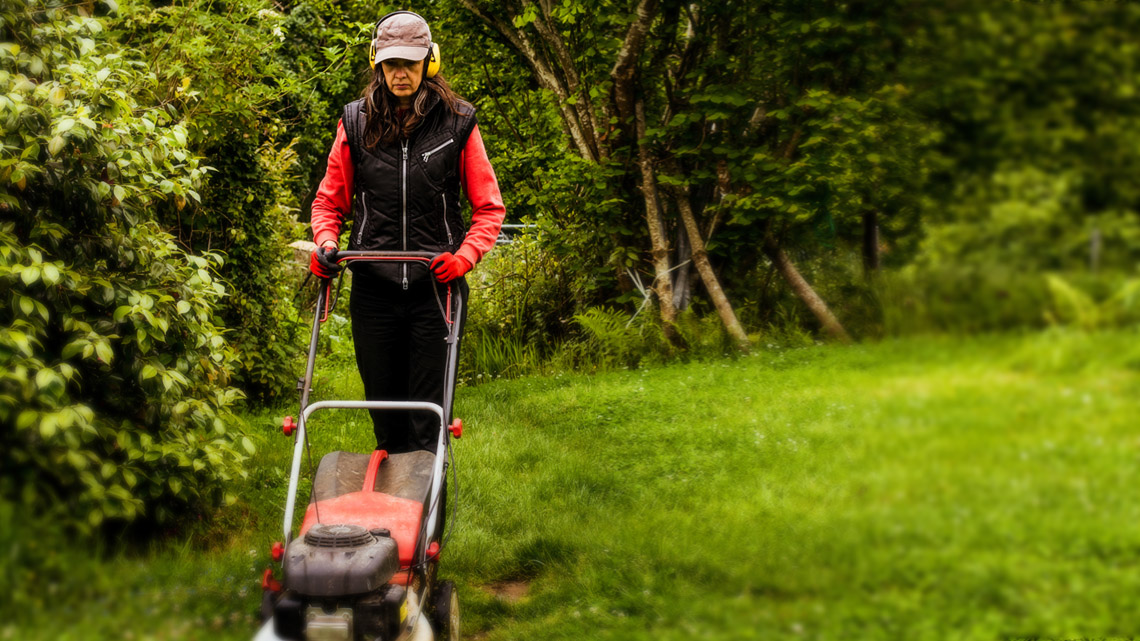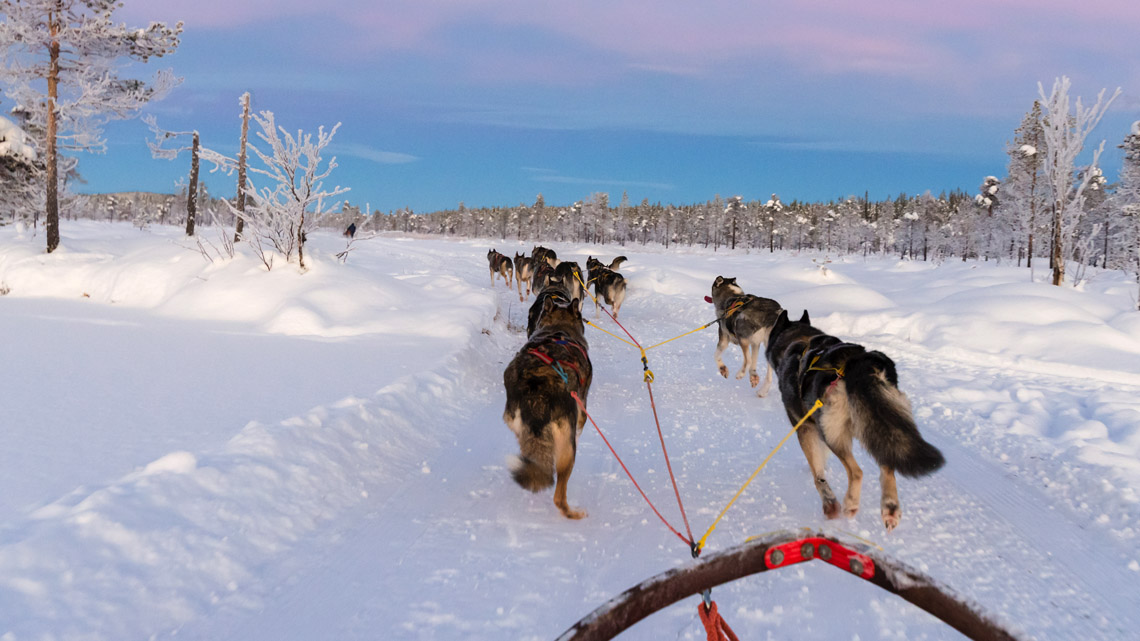Minds On
Designing a system or machine

Brainstorm
Brainstorm
What do you think is important for an engineer to consider when designing a system, gadget, or machine? Why?
Brainstorm and record your ideas in a notebook or another method of your choice.
Press ‘Let’s Check!’ to access possible responses.
You may have considered efficiency and safety.
- Efficiency is the ratio of the useful work performed by a machine or in a process.
- Safety is the condition of being protected from or unlikely to cause danger, risk, or injury.
What do you think?
How might an engineer test for the efficiency and safety of a device?
Come up with as many solutions as you can.
Record your ideas in a notebook or another method of your choice.
Action
Simple machines
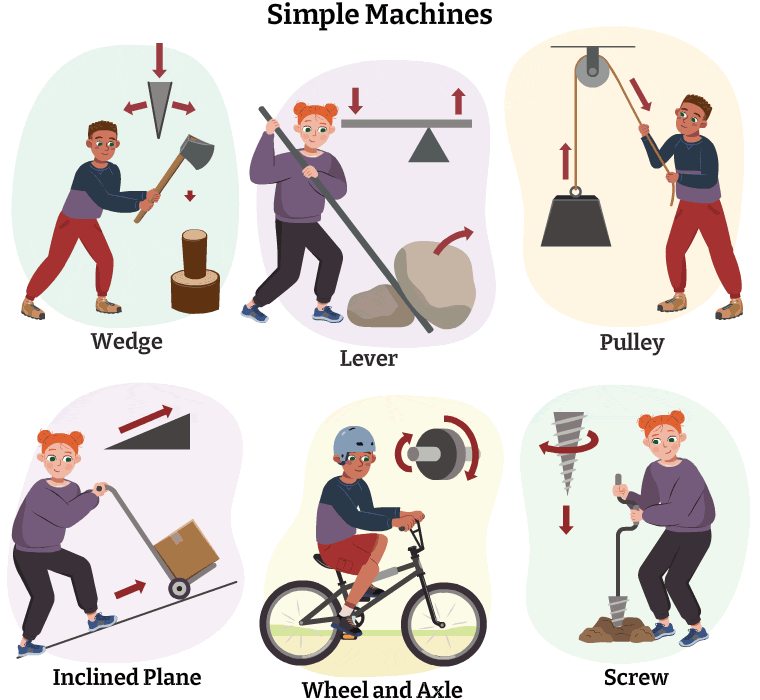
These animations show how the six different simple machines are used to move objects. There are arrows to represent how the force is being changed. The wedge is an axe. There is a learner holding an axe and cutting wood. The force of moving the axe down into the wood moves the force down and outward from the wood., The lever is a long pole. Another learner is holding the pole. One end of the pole is underneath a big rock. The force of pushing down on the pole lifts the rock upwards. There is a learner holding one end of a rope that is moving through a pulley. At the end of the role is a heavy weight. As the learner pulls down on the rope, the weight is lifted up. The inclined plane is a ramp. A learner is pushing a box up the ramp on a cart. As the learner pushes the cart, the cart moves up the ramp. The wheel and axles are on a bicycle. A learner is riding the bicycle. As the learner pushes their feet on the pedals, the wheels turn around. The screw is a long tool used for digging into the ground. A learner is turning the screw, and the screw is moving around and down into the ground.
A simple machine is a basic mechanical device used to apply force. Many simple machines make tasks easier.
For each simple machine, select the corresponding description.
Key terms
Explore the following key terms and descriptions to learn more about simple machines. Press the flip button to access both sides of the cards. Use the arrow keys to navigate between cards.
Did You Know?
Did you know?
When a force is uses to cause movement or displacement of an object, this is called work. It is calculated with two variables: force and distance. The ability to do work is called energy. Energy cannot be created or destroyed; it can only be transferred from one object to another. When energy is transferred, the total amount of energy always remains constant. Energy is measured as potential and kinetic energy.
Daily examples
Let’s explore the following images:
Test Your Skills!
Test your skills
- After checking out the images, think of and choose two everyday examples of work and forces.
-
Then, describe the work using the following
terms:
- displacement
- force
- work
- energy
- efficiency
Press ‘Hint’ to access a few examples.
Some possible everyday examples you could choose are:
- using a bow and arrow
- pulling a wagon
- lifting weights
- riding a bike
Record your description in a notebook or another method of your choice.
Future impacts
This learning activity connects new and existing approaches for young scientists to create positive changes in their communities.

One engineering objective is to help people through advancements in technology. Designing and building is essential to engineering. Engineers follow the steps of the design process to help them create the best possible solutions to real-world problems.
Explore this video to learn about the steps of the Engineering Design Process.
Investigate
Investigate
Rube Goldberg was a famous artist who went to school to be an engineer. He drew cartoons of inventions that did simple tasks, but in complicated ways.
Let’s investigate the following image and invention. What do you notice?

A device resembling Rube Goldberg famous cartoon inventions
Diagram on a chalkboard.
1. Paper unrolls into a waste basket.
2. The weight pulls a pulley, which opens a bird cage.
3. The bird flies out of the cage and hits a ball.
4. The ball rolls down ramps toward dominoes.
5. The dominoes fall, dropping an axe.
6. The axe cuts a rope.
7. The cut rope moves up to a pulley.
8. The pulley causes a hammer to drop on the top of a scale.
9. The top of the scale moves down.
10. A statue hand that is also on top of the scale moves down, pulling the switch string of a light bulb, turning on the light bulb.
If you noticed, all of Rube Goldberg’s inventions involve complex systems that were made from simple machines.
Which simple machines?
We will now explore and evaluate the design of a machine and the usefulness for its audience.
Press the following tabs to access two of Rube Goldberg’s designs and cartoons.
Check out the following Rube Goldberg design and cartoon. What simple machines do you notice being used?
Record your observations in a notebook or another method of your choice.
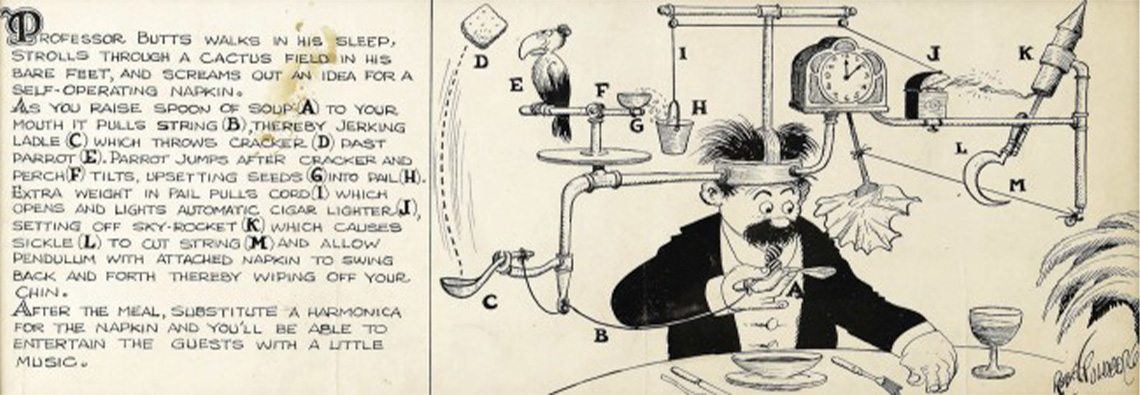
A Rube Goldberg Machine. A diagram for a self-operating napkin.
As you raise a spoon of soup to your mouth, it pulls a string, which flicks a spoon.
Flicking the spoon throws a cracker past a parrot. The parrot jumps after the cracker, and its perch tilts.
The tilting perch spills seeds into a pail. The new weight in the pail pulls a cord which lights a lighter.
The lighter sets off a rocket which pulls a blade to cut a string. The cut string releases a pendulum with an attached napkin to swing back and forth in front of your face.
Check out the following Rube Goldberg design and cartoon. What simple machines do you notice being used?
Record your observations in a notebook or another method of your choice.
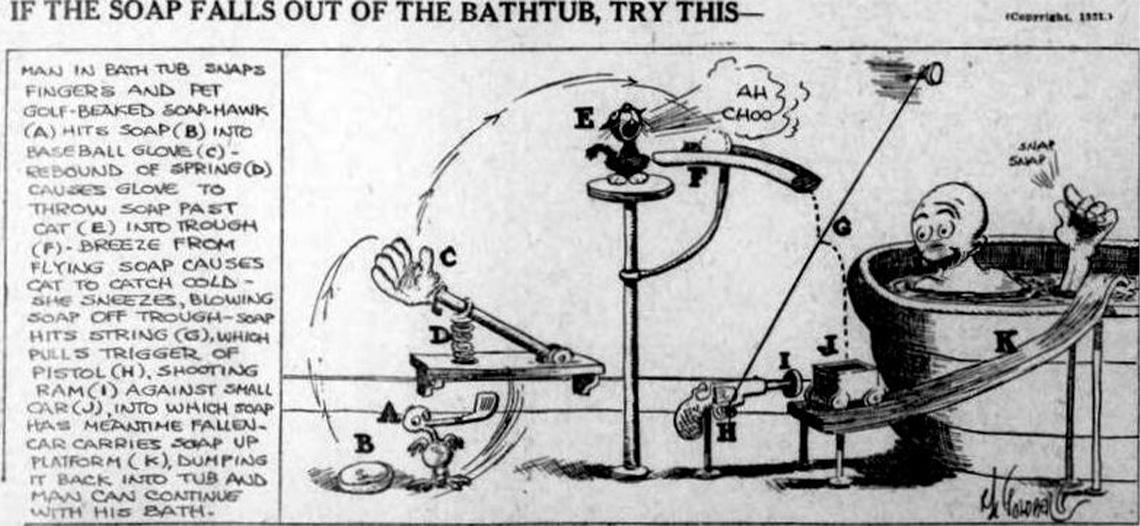
A Rube Goldberg Machine. If the bar of soap falls out of the bathtub, try this.
Man in bathtub snaps fingers and pet golf-beaked soap-hawk hits soap into baseball glove. The rebound of a spring causes the glove to throw soap past a cat into a trough.
The breeze from the flying soap causes the cat to catch a cold. She sneezes, blowing the soap off the trough.
The soap hits a string which pulls trigger of pistol, shooting a small wagon into which the soap has fallen in the meantime.
The wagon carries the soap up a platform, dumping it back into the tub.
The man can continue with his bath now.
Press ‘Let’s Check!’ to access the simple machines in Designs A and B.
Design A: pulley, lever, and wheel and axle
Design B: pulley lever, incline plane, and wheel and axle
Let’s design it!
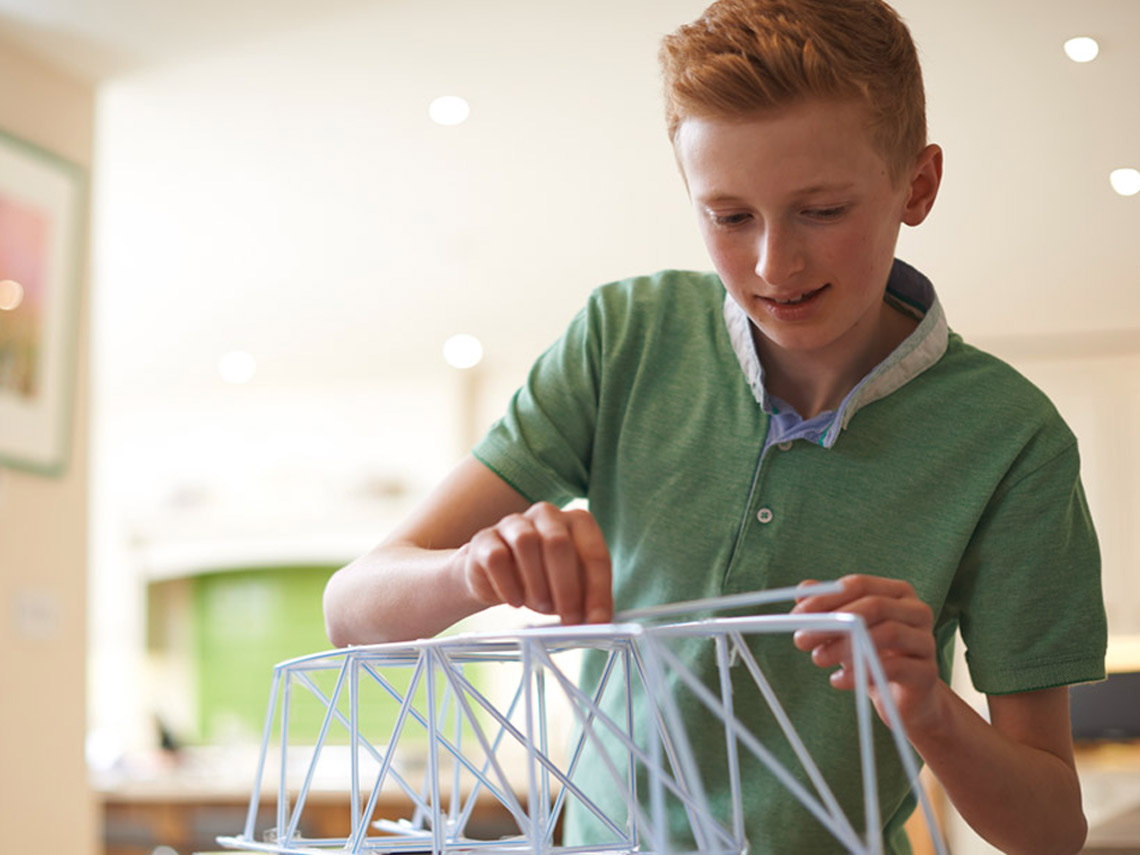
Your task is to design your own Rube Goldberg Machine, and if possible, build and test your design.
-
When planning your machine’s design, be sure to include
the following:
- a solution to an everyday problem
- at least six to eight different steps
- at least three different simple machines
- calculations of the mechanical advantage and work of your machines
Press ‘Hint’ to access a few ideas for your machine’s design.
Suggested ideas
Your device could be a machine for:
- turning on or off a light switch
- dropping a bottle into a recycling bin
- watering a plant
- planting seeds in a pot of soil
- shutting a door
- turning off an alarm clock
- putting food in a pet bowl
-
When designing your machine, consider the following:
- what materials you would use
- how your machine might function
- what obstacles you might encounter during the testing phase
If possible, build a prototype of your design using appropriate materials, and test your machine.
Press ‘Hint’ to access a few materials for your machine’s design.
Suggested materials
For your design, you may use any household materials you have available! You should consider using recycled materials.
Some ideas are (but are not limited to):
- cardboard boxes
- paper towel rolls
- materials from outside (sticks on the ground, bark, rocks, etc.)
- building blocks or other building toys
- glue
- plastic containers or recycled bottles
Student Tips
Student tips
Press the following tabs to access formulas to guide your calculations.
Mechanical advantage (MA) is the ratio of force produced by a machine to the force applied to it.
It is typically used to assess the performance of a machine, and can be calculated using the following formula:
In other words:
Mechanical advantage = Output force ÷ Input force
- Output force is the force exerted by a machine.
- Input force is a force applied to a mechanism.
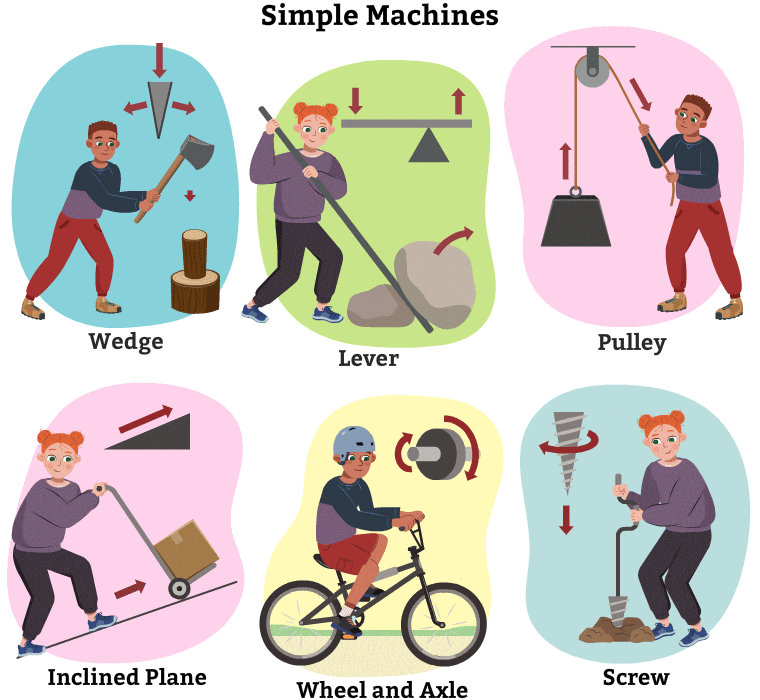
Work is considered the transfer of energy through motion, and can be calculated using this formula:
In other words:
Work = Force × Distance
-
Record your plan and design for your simple machine. Complete the My Simple Machine Activity in your notebook or using the following fillable and printable document. If you would like, you can use speech-to-text or audio recording tools to record your thoughts.
Steps
Your response
Ask
What is the problem you are trying to solve?
What simple task will your machine do?
Research and imagine
What are some possible solutions?
Brainstorm your ideas and consider what simple machines it will include.
Plan
Plan a design and create a drawing that includes all materials you may need.
Label materials and identify simple machines being used
Create
If possible, build your first prototype of your device.
Test
If possible, test your device. Record your observations.
What changes do you need to make? Why?
Improve
Does this solve the problem? How can the design be improved?
Communicate
Share your device with others in a method of your choice. Create an advertisement for the machine that you created in one of the following methods:
Turn your design into a newspaper advertisement (just like Rube Goldberg used to do!) and explain what purpose it serves with step-by-step instructions of the machine.
Create a poster (in print or digitally) that explains the purpose your machine serves with step-by-step instructions of the machine.
Create an audio recording of yourself that explains the purpose your machine serves with step-by-step instructions of the machine.
Be sure to include:
the purpose or function of your machine (Hint: What does it do?)
the simple machines included in your design
how your machine works (step-by-step)
Calculate
Calculate the mechanical advantage and work of two of the simple machines that you included.
Press the ‘Activity’ button to access the My Simple Machine Activity.
You may use the following checklist to guide how you communicate your simple machine’s design.
Communicate your learning by:
Press ‘Optional’ to access an optional step and activity.
Optional: If possible, build and test your simple machine design.
Always be sure to do your safety checks before building and testing your design!
Consolidation
Review your learning

For each sentence, select the missing letter, word, or phrase from the drop-down menu.
Pause and Reflect
Pause and reflect
One important part of engineering is evaluating the design of a machine, and its usefulness to its audience.
Let’s reflect on the following:
- How useful do you think your machine will be? Why?
- Do you think you could have created a machine that worked more efficiently but gave you the same results? Explain.
- Describe your simple machine using the following scientific terms: displacement, force, work, efficiency and energy.
- Lastly, were there safety concerns with your machine, if it was applied in the real-world? What were they? How could they be avoided if you redesigned your machine?
Record your ideas in a notebook or another method of your choice.
Reflection
As you read the following descriptions, select the one that best describes your current understanding of the learning in this activity. Press the corresponding button once you have made your choice.
I feel…
Now, expand on your ideas by recording your thoughts using a voice recorder, speech-to-text, or writing tool.
When you review your notes on this learning activity later, reflect on whether you would select a different description based on your further review of the material in this learning activity.
